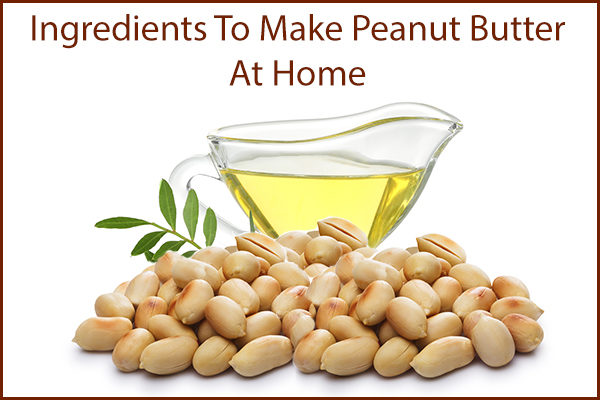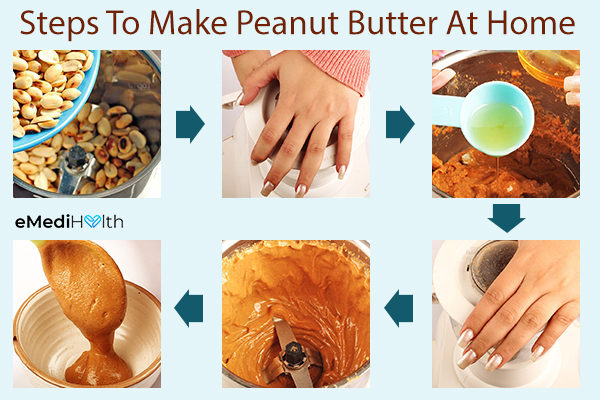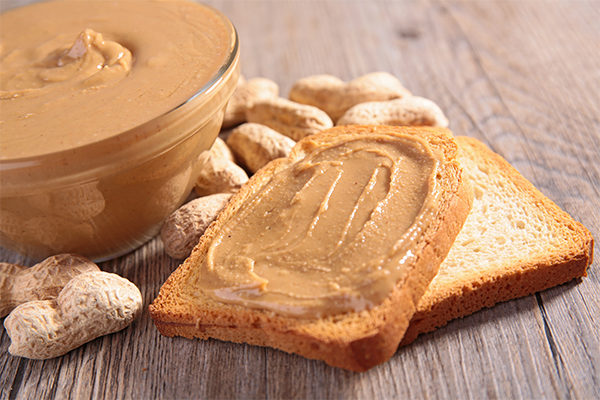In this article:
Peanuts are grown all over the world. They have a characteristic woody, earthy flavor, which becomes stronger as the crop matures.

Peanuts are packaged as roasted, fried, seasoned, or candied snacks. They are also used as functional ingredients in a range of processed foods such as confectionaries, soups, and desserts and as meat extenders.
Peanuts can be consumed as whole nuts or their by-products, including peanut oil, peanut flour, and peanut butter. Nearly half of all peanut consumption in the United States is in the form of peanut butter, (1) which points to the overwhelming demand for this food spread.
Homemade Peanut Butter Recipe
Store-bought peanut butter often contains added sugar and hydrogenated fats that take away from its overall nutritional value. The good news is you can make your own unadulterated peanut butter at home in just a couple of minutes.
This hassle-free recipe will provide you the best quality and nutritional value of peanut butter without compromising its taste.
Ingredients:

- 2 cups of unsalted, roasted peanuts
- 2–3 teaspoons of extra-virgin olive oil
Directions:

- Put 2 cups of roasted peanuts into a food processor.
- Grind them for a few seconds until they turn into powder.
- Add 2–3 teaspoons of extra-virgin olive oil into the grinder.
- Process the peanut and oil mixture again to make a very smooth paste.
- Keep scraping down the sides of the grinding bowl from time to time to avoid wastage.
- Transfer the peanut butter into a storage container.
Tips:
- If roasted peanuts are not available, you can take regular shelled peanuts and dry roast them yourself in an oven at a temperature setting of 160–180°C (325–350°F) for about 15–20 minutes. You can also roast them on a stove for 20 minutes, stirring occasionally so that they do not burn on one side, or cook them in a microwave for 10–12 minutes. Since the cooking process continues even after you take the peanuts off the heat, it is all the more necessary not to overcook them.
- Once the nuts are cool enough to touch, rub them together in your palms to remove their papery brown skin.
- If you are out of olive oil, you can use peanut oil or any other vegetable oil in its place, but pure olive oil is the preferred option.
- You can add finely ground sea salt, cinnamon powder, cocoa powder, honey, or maple syrup to enhance the flavor of your homemade peanut butter.
- Refrigerating your homemade peanut butter can extend its shelf life and keep it from going bad for months.
- You can make peanut-almond butter in the same way by using equal parts of both nuts.
- People with peanut allergies are strictly prohibited from consuming peanut butter, as it can trigger potentially deadly reactions.
Disclaimer: Peanut allergies are not only extremely prevalent, but they can often result in severe anaphylactic shock. In fact, peanuts are the most commonly reported cause of anaphylaxis, a rapid allergic reaction that occurs within seconds or minutes of exposure to the allergen. (7)
Anaphylaxis occurs suddenly and can lead to unconsciousness or death if not treated immediately. Thus, people with a peanut allergy must exercise special precautions with regard to their food choices, when buying groceries, or when eating out.
Benefits of Peanuts and Peanut Butter

Peanuts belong to the legume family, which implies they are sources of plant proteins. But there is more to their nutritional reserve than just that.
- This popular nut contains a variety of bioactive compounds such as dietary fibers, healthy fatty acids, polyphenols, antioxidants, vitamins, and minerals.
- Peanuts also contain some amount of saturated fat but have a much larger share of heart-healthy monounsaturated and polyunsaturated fats.
- Much of the nutritional goodness of peanuts is retained in peanut butter, making it nutritionally superior to most breakfast spreads such as butter, cheese, jam, and mayonnaise.
- Peanut butter can be considered a high-calorie food, so it should be consumed in moderation as part of a balanced diet. One serving size of peanut butter is 2 tablespoons.
- Peanut butter provides essential vitamins and minerals, including vitamins E, B3, and B6, magnesium, manganese, iron, zinc, and folate. It also provides about 558 mg of potassium while containing only 17 mg of sodium so long as the nuts are unsalted. This makes for an excellent potassium-to-sodium ratio, which is vital for maintaining a healthy electrolyte balance in the body. (2) The protein and dietary fiber found in these nuts promote satiety and keep you full for longer, thereby reducing your overall food intake. Also, not all the energy from peanuts is absorbed. (3)
- Peanuts and peanut butter may be rich in calories due to their inherent fat content, but they are still considered good for weight management. (4)
- Peanuts and peanut butter are credited with multiple health virtues owing to their rich nutrient composition.
- The combination of healthy monounsaturated fatty acids, plant proteins, magnesium, potassium, fiber, and arginine, along with several other bioactive components found in peanuts, may play a role in reducing and managing hypertension. (3)
- Moreover, these nuts contain other organic compounds such as tocopherols, phytochemicals, flavonoids, and resveratrol, all of which exhibit significant antioxidant activity that may help inhibit the growth of cancer cells and decrease cardiovascular risk. (1)(5)
Note: Peanuts contain aflatoxins, which can increase your risk of developing liver and kidney diseases when consumed in excess. (6) However, considerable amounts of these toxins get removed in the large-scale production of peanut butter from raw peanuts, which greatly reduces the health risk.
Uses of Peanut Butter
Peanut butter has a mild earthy flavor that goes well with a lot of things.
- You can enjoy this homemade spread with whole-grain bread, oatmeal, cut apples, banana slices, or celery sticks.
- You can also use it for making a wide variety of sweet items such as cookies, muffins, crepes, and ice cream.
- Another easy preparation to make with homemade unsalted peanut butter is adding it to a smoothie. Simply add a spoonful of peanut butter to a concoction of other nutritious ingredients such as banana, yogurt, and milk to fix yourself a peanut butter-flavored smoothie.
Final Word
Peanut butter serves as a heart-healthy alternative to regular butter, margarine, jams, marmalade, cheese, and other spreads. It packs quite a nutritional punch while offering a delectable taste that is palatable to kids and adults alike.
You can derive the health benefits of homemade peanut butter by adding it to a variety of dishes and drinks or eating it raw but only in recommended amounts. You can buy peanut butter from the market or make it at home.
The advantage of making your own peanut butter is that you can exercise full control over product quality. You can use only the best ingredients to make your peanut butter and avoid harmful additives that are found in commercial varieties. Moreover, you can add different nuts or adjust the ingredient proportions to suit your taste.
- Was this article helpful?
- YES, THANKS!NOT REALLY


